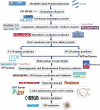Multi-epitope chimeric vaccine design against emerging Monkeypox virus via reverse vaccinology techniques- a bioinformatics and immunoinformatics approach
- PMID: 36091024
- PMCID: PMC9452969
- DOI: 10.3389/fimmu.2022.985450
Multi-epitope chimeric vaccine design against emerging Monkeypox virus via reverse vaccinology techniques- a bioinformatics and immunoinformatics approach
Abstract
The emerging monkeypox virus (MPXV) is a zoonotic orthopoxvirus that causes infections in humans similar to smallpox. Since May 2022, cases of monkeypox (MPX) have been increasingly reported by the World Health Organization (WHO) worldwide. Currently, there are no clinically validated treatments for MPX infections. In this study, an immunoinformatics approach was used to identify potential vaccine targets against MPXV. A total of 190 MPXV-2022 proteins were retrieved from the ViPR database and subjected to various analyses including antigenicity, allergenicity, toxicity, solubility, IFN-γ, and virulence. Three outer membrane and extracellular proteins were selected based on their respective parameters to predict B-cell and T-cell epitopes. The epitopes are conserved among different strains of MPXV and the population coverage is 100% worldwide, which will provide broader protection against various strains of the virus globally. Nine overlapping MHC-I, MHC-II, and B-cell epitopes were selected to design multi-epitope vaccine constructs linked with suitable linkers in combination with different adjuvants to enhance the immune responses of the vaccine constructs. Molecular modeling and structural validation ensured high-quality 3D structures of vaccine constructs. Based on various immunological and physiochemical properties and docking scores, MPXV-V2 was selected for further investigation. In silico cloning revealed a high level of gene expression for the MPXV-V2 vaccine within the bacterial expression system. Immune and MD simulations confirmed the molecular stability of the MPXV-V2 construct, with high immune responses within the host cell. These results may aid in the development of experimental vaccines against MPXV with increased potency and improved safety.
Keywords: immune simulation; molecular dynamic simulation; monkeypox virus; multi-epitope vaccine construct; reverse vaccinology; vaccine candidates.
Copyright © 2022 Aiman, Alhamhoom, Ali, Rahman, Rastrelli, Khan, Farooq, Ahmed, Khan and Li.
Conflict of interest statement
The authors declare that the research was conducted in the absence of any commercial or financial relationships that could be construed as a potential conflict of interest.
Figures









Similar articles
-
Immunoinformatic-guided novel mRNA vaccine designing to elicit immunogenic responses against the endemic Monkeypox virus.J Biomol Struct Dyn. 2024 Aug;42(12):6292-6306. doi: 10.1080/07391102.2023.2233627. Epub 2023 Jul 9. J Biomol Struct Dyn. 2024. PMID: 37424185
-
Immunoinformatics design of multivalent epitope vaccine against monkeypox virus and its variants using membrane-bound, enveloped, and extracellular proteins as targets.Front Immunol. 2023 Jan 26;14:1091941. doi: 10.3389/fimmu.2023.1091941. eCollection 2023. Front Immunol. 2023. PMID: 36776835 Free PMC article.
-
Contriving multi-epitope vaccine ensemble for monkeypox disease using an immunoinformatics approach.Front Immunol. 2022 Oct 13;13:1004804. doi: 10.3389/fimmu.2022.1004804. eCollection 2022. Front Immunol. 2022. PMID: 36311762 Free PMC article.
-
Current Status of Vaccine Development for Monkeypox Virus.Adv Exp Med Biol. 2024;1451:289-300. doi: 10.1007/978-3-031-57165-7_18. Adv Exp Med Biol. 2024. PMID: 38801585 Review.
-
Monkeypox virus: a re-emergent threat to humans.Virol Sin. 2022 Aug;37(4):477-482. doi: 10.1016/j.virs.2022.07.006. Epub 2022 Jul 9. Virol Sin. 2022. PMID: 35820590 Free PMC article. Review.
Cited by
-
A computational approach to developing a multi-epitope vaccine for combating Pseudomonas aeruginosa-induced pneumonia and sepsis.Brief Bioinform. 2024 Jul 25;25(5):bbae401. doi: 10.1093/bib/bbae401. Brief Bioinform. 2024. PMID: 39133098 Free PMC article.
-
Immunoinformatics-Aided Design of a Peptide Based Multiepitope Vaccine Targeting Glycoproteins and Membrane Proteins against Monkeypox Virus.Viruses. 2022 Oct 27;14(11):2374. doi: 10.3390/v14112374. Viruses. 2022. PMID: 36366472 Free PMC article.
-
In Silico Design and Characterization of a Multiepitope Vaccine Candidate Against Brucella canis Using a Reverse Vaccinology Approach.J Immunol Res. 2025 Apr 15;2025:6348238. doi: 10.1155/jimr/6348238. eCollection 2025. J Immunol Res. 2025. PMID: 40265107 Free PMC article.
-
Exploratory algorithms to devise multi-epitope subunit vaccine by examining HIV-1 envelope glycoprotein: An immunoinformatics and viroinformatics approach.PLoS One. 2025 Feb 27;20(2):e0318523. doi: 10.1371/journal.pone.0318523. eCollection 2025. PLoS One. 2025. Retraction in: PLoS One. 2025 May 6;20(5):e0324076. doi: 10.1371/journal.pone.0324076. PMID: 40014623 Free PMC article. Retracted.
-
Multi-Epitope Vaccine for Monkeypox Using Pan-Genome and Reverse Vaccinology Approaches.Viruses. 2022 Nov 12;14(11):2504. doi: 10.3390/v14112504. Viruses. 2022. PMID: 36423113 Free PMC article.
References
-
- Moore M, Rathish B, Zahra F. Monkeypox. Wkly Epidemiol Rec (2011) 86(41):448–51. - PubMed
Publication types
MeSH terms
Substances
LinkOut - more resources
Full Text Sources
Medical
Research Materials

